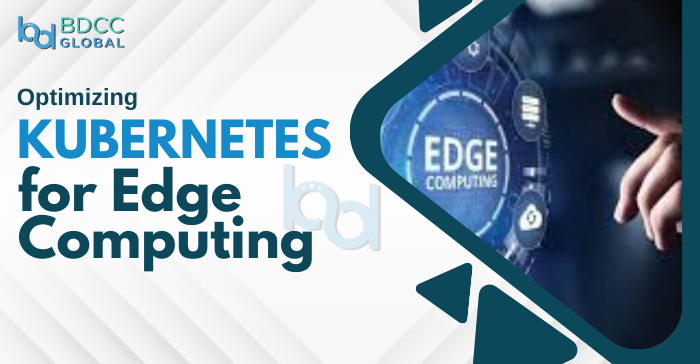
What if the future of computing lies not in massive data centers but at the edge of the network, closer to where data is generated and consumed? This is the promise of Kubernetes edge computing, an innovation that brings computing power more closely to the origin of data, allowing for real-time decision-making, lower latency, and better bandwidth use.
However, managing Kubernetes distributed workloads across thousands of edge devices presents significant challenges, from resource constraints to network reliability.
This article explores how Kubernetes is transforming Kubernetes edge computing, offering strategies for managing Kubernetes distributed workloads, and introducing cutting-edge innovations like AI-driven edge computing orchestration.
What is Edge Computing?
Kubernetes edge computing is the technique of handling information close to where it was generated rather than transferring it to a centralized data center or the cloud. This strategy decreases latency, saves bandwidth, and allows for real-time decision-making. Kubernetes edge computing is particularly relevant in applications like IoT, autonomous vehicles, smart cities, and industrial automation, where milliseconds matter.
Challenges in Edge Computing:
- Latency: In apps that involve autonomous driving or industrial automation, even little latency in handling information might have serious effects. Kubernetes edge computing minimizes latency by analyzing information locally.
- Scalability: Kubernetes distributed workloads often involve thousands of devices spread across multiple locations. Managing these devices and ensuring consistent performance is a complex task.
- Resource Constraints: Edge devices often have low computing, storage, and energy capabilities. Optimizing these resources is crucial for smooth operation.
- Network Reliability: Edge computing orchestration often works in environments with intermittent connectivity or limited bandwidth. Ensuring reliable communication between edge nodes and central systems is a major challenge.
Kubernetes: A Primer for Edge Computing
Kubernetes is a free platform meant to simplify installing, scaling, and administration of containerized applications. It provides a strong foundation for operating Kubernetes distributed workloads while maintaining high availability, scalability, and resilience.
At its core, Kubernetes includes:
- Master Node: Controls the cluster and handles workloads.
- Worker Nodes: Run the apps in containers.
- Pods: The tiniest deployable units in Kubernetes, containing one or more containers.
- Services provide communication between various components of an application.
Why Kubernetes for Edge Computing?
Containerization in Edge Computing: Containers isolate applications and their interdependence, making them adaptable and lightweight. This is ideal for Kubernetes edge computing, where resources are limited.
Kubernetes Distributed Workloads: Kubernetes excels at managing workloads across distributed environments, making it well-suited for Kubernetes edge computing.
Edge Computing Orchestration: Kubernetes provides tools for automating deployment, scaling, and management, which are essential for Kubernetes distributed workloads.
Kubernetes Edge Computing: Key Concepts and Components
To understand how Kubernetes fits into Kubernetes edge computing, it’s essential to examine the tools and frameworks specifically designed for this purpose. These include lightweight Kubernetes distributions and specialized platforms that extend Kubernetes to the edge.
KubeEdge
KubeEdge is an open-source platform that extends Kubernetes to the edge, enabling seamless edge computing orchestration. It addresses the unique challenges of Kubernetes distributed workloads, such as unreliable network connectivity and resource constraints. Key components include:
- Cloud Core: Manages communication between the cloud and edge nodes, ensuring synchronization and control.
- Edge Core: Runs on edge devices, handling workload execution and reporting status back to the cloud.
- DeviceTwin: Synchronizes the state of edge devices with the cloud, allowing real-time monitoring and handling.
MicroK8s
MicroK8s is a lightweight Kubernetes distribution designed for Kubernetes edge computing. It is easy to deploy and manage, making it suitable for resource-constrained environments. MicroK8s is particularly useful for IoT gateways and small-scale edge deployments, where simplicity and efficiency are critical.
K3s
K3s is another lightweight Kubernetes distributed workloads optimized for edge computing. It is made to run on low-power devices and is widely used in IoT and industrial automation. K3s strips away non-essential components, making it a compact and efficient solution for edge environments.
Edge Nodes and Clusters
Edge nodes differ from traditional cloud nodes in that they are often geographically dispersed and have limited resources. Handling these nodes needs unique tools and strategies. Kubernetes has features like as node affinity and taints/tolerations that allow administrators to regulate where workloads run, resulting in optimal placement and resource usage.
Managing Distributed Workloads with Kubernetes
With these tools and frameworks in place, Kubernetes is well-equipped to handle the unique demands of Kubernetes edge computing. However, managing Kubernetes distributed workloads across edge environments requires a deeper understanding of workload distribution strategies and Kubernetes features.
Workload Distribution Strategies
To ensure efficient workload management at the edge, it’s crucial to adopt strategies that optimize resource utilization, minimize latency, and ensure fault tolerance. Kubernetes provides several features that make this possible.
Workload Distribution Strategies:
- Geographical Distribution: Placing workloads closer to the data source is a fundamental principle of edge computing. Kubernetes enables geographical distribution through features like node affinity, which ensures that workloads are deployed on nodes in specific locations.
- Load Balancing: Distributing workloads evenly across edge nodes is essential for optimal resource utilization. Kubernetes automatically balances workloads across nodes, preventing overloading and ensuring consistent performance.
- Fault Tolerance: Edge environments are prone to failures due to network issues or hardware limitations. Kubernetes ensures fault tolerance through redundancy and failover mechanisms. For example, if an edge node fails, Kubernetes can automatically reschedule workloads on other nodes.
Kubernetes Features for Distributed Workloads
- Node Affinity and Taints/Tolerations: These features allow administrators to control where workloads run. Node affinity ensures that workloads are placed on specific nodes, while taints and tolerations prevent workloads from being scheduled on unsuitable nodes. Help control workload placement, ensuring efficient edge computing orchestration.
- Horizontal Pod Autoscaler (HPA): The HPA automatically scales applications based on demand. This is particularly useful in edge environments, where resource availability can fluctuate.
- StatefulSets and DaemonSets: StatefulSets manage stateful applications, ensuring that data is preserved even if pods are rescheduled. DaemonSets ensure that system-level services run on all nodes, providing essential functionality across the edge cluster.
Edge Computing Orchestration
- Multi-Cluster Management: Managing multiple edge clusters can be challenging. Tools like Rancher and Kubefed enable centralized management of multiple clusters, simplifying administration and ensuring consistency.
- Service Mesh: Implementing a service mesh like Istio or Linkerd ensures reliable communication between services at the edge. This is particularly important in distributed environments, where network reliability can be an issue.
AI-Driven Edge Orchestration with Kubernetes
AI can optimize workload distribution and resource allocation at the edge by analyzing data in real-time and making intelligent decisions. Edge computing orchestration benefits from AI-powered predictive scaling, resource allocation, and energy efficiency.
Custom Kubernetes schedulers that use machine learning can predict and optimize workload placement. For example:
- KubeAI: Integrates AI models into Kubernetes to optimize resource allocation.
- KubeFlow: A platform for running machine learning workflows on Kubernetes.
Benefits of AI-Driven Orchestration
- Dynamic Resource Allocation: AI can adapt to changing conditions in real-time, ensuring that resources are used efficiently.
- Predictive Scaling: AI can anticipate demand and scale resources proactively, reducing latency and improving performance.
- Energy Efficiency: AI can optimize power consumption at the edge, extending the lifespan of edge devices.
Challenges and Future Directions
While Kubernetes provides powerful tools for managing distributed workloads, edge computing also presents unique challenges that require innovative solutions. Let’s explore these challenges and the future directions that could shape the evolution of edge computing.
- Security: Edge devices are often deployed in uncontrolled environments, making them vulnerable to physical and cyber threats. Securing edge nodes and data in transit requires robust encryption, secure boot mechanisms, and zero-trust architectures.
- Interoperability: Edge environments typically involve a mix of devices from different manufacturers, each with its own protocols and standards. Ensuring compatibility between these devices and Kubernetes distributions is essential for seamless operation.
- Complexity: Managing distributed systems at scale is inherently complex. Organizations need tools and strategies to simplify deployment, monitoring, and maintenance of edge clusters.
Future Directions
It’s sure that Kubernetes will continue to play a central role in edge computing. Organizations may maximize the benefits of edge computing by tackling current issues and embracing upcoming technology.
- 5G and Kubernetes: The deployment of 5G networks will considerably improve Kubernetes’ edge computing capabilities. With higher speeds and reduced latency, 5G will allow for real-time communication between edge nodes, creating new opportunities for applications like as autonomous cars and smart cities.
- Edge-Native Applications: As edge computing matures, we can expect to see more applications specifically designed for edge environments. These applications will be optimized for low latency, resource efficiency, and fault tolerance.
- Quantum Computing: While still in its early stages, quantum computing has the potential to revolutionize edge computing orchestration. Quantum algorithms could optimize workload distribution and resource allocation, leading to unprecedented levels of efficiency.
Parting Thoughts
Kubernetes has emerged as a critical tool for Kubernetes edge computing. By leveraging Kubernetes and staying ahead of these trends, organizations can build resilient, efficient, and scalable Kubernetes distributed workloads that meet the demands of the modern world.
By leveraging Kubernetes and staying ahead of these trends, organizations can build resilient, efficient, and scalable edge computing solutions that meet the demands of the modern world.
BDCC
Latest posts by BDCC (see all)
- Cloud computing in healthcare: Uses and benefits - June 23, 2025
- What are the Best Practices for Terraform File Structure? - June 10, 2025
- From Monolith to Microservices: DevOps Strategies For a Smooth Transition - June 5, 2025

